Certainly Coke would not be the global brand it is without the Americanization of the global psyche.Coke is it. An artificial unfulfilled promise. After all, the product of the Coca Cola company is advertising and its creation of desire. “Coca Cola should always be within an arm’s reach of desire.” – Robert Woodruff. It is the most widely recognized U.S. brand worldwide and is part of the many forms of hegemony and American cultural colonization; imperialism as a way of promoting the “American way of life” the free market and liberty; the worldwide ideal of the house with the white picket fence, boy gets girl and the good guys ride off into the sunset. A global fantasy.
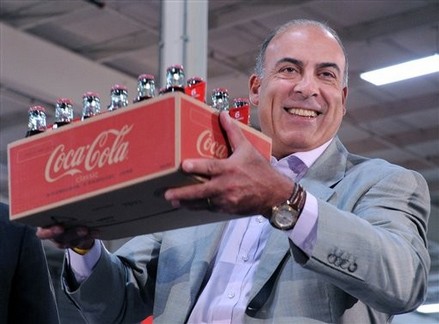
---This photo provided by Coca-Cola Co. , shows Coca-Cola Company Chairman and CEO Muhtar Kent accepting the first case of Coca-Cola produced by the new Coca-Cola Refreshments, Inc. at a special Town Hall for employees Tuesday, Oct. 5, 2010, in Dunwoody, GA.--- Read More:http://www.daylife.com/topic/Muhtar_Kent/photos
Still, unwrapped of its qualitative dimension, Coke in its various representations is still a sweetened, carbonated beverage in a can or bottle.It fulfills none of the ostensible needs of a drink: thirst, nutrition and taste, the latter of which is debatable. All that’s left is an object cause of desire. The marketing, it purchase and consumption is intrinsically banal. So, its a bit misguided to associate the drinking of a Coke with any ideal or values. In fact, its incredible to think: Coca Cola advertising campaigns have provided the public with lots of beautiful images, which have engaged a lot of creative resources…. all to sell dumb bottled pop.
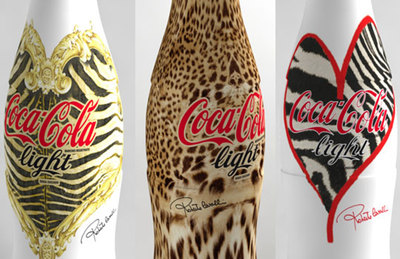
---The coolest soft drink bottles at the moment would have to be Coca Cola Light bottles designed by Roberto Cavalli. The limited run of 300,000 bottles will be distributed exclusively in Italy so unfortunately the Coca Cola addicts here at Sweaty Betty won’t be able to get their hands on one- but that won’t stop them from drinking Coke! --- Read More:http://www.sweatybettypr.com/blog/?m=200808&paged=2
Slavoj Zizek: It’s no surprise that Coca-cola was first introduced as a medicine. Its strange taste seems to provide no particular satisfaction. It is not directly pleasing, however, it is as such, as transcending any use–value, like water, beer or wine, which definitely do quench our thirst, that Coke functions as the direct embodiment of “IT”, the pure surplue of enjoyment over standard satisfactions. It is the mysterious and elusive X we are all after in our compulsive consumption. The unexpected result of this is not that, since Coke doesn’t satisfy any concrete need we drink it only as supplement, after some other drink has satisfied our substantial need — it is rather this very superfluous character that makes our thirst for Coke all the more insatiable. Coke has the paradoxical quality that the more you drink it, the more you get thirsty. So, when the slogan for Coke was “Coke is it!”, we should see in it some ambuigity — it’s “it” precisely insofar as it’s never IT, precisely insofar as every consumption opens up the desire for more. The paradox is thus that Coke is not an ordinary commodity, but a commodity whose very peculiar use–value itself is already a direct embodiment of the auratic, ineffable surplus.Read More:http://www.egs.edu/faculty/slavoj-zizek/articles/the-superego-and-the-act/
…Internationally, the downfall of colonialism did not deter the influence of the Western democracies on their former colonies. The paralyzing of the economies of pre-colonial countries was such that by the time of independence, many developing countries would be locked into a global trading system that is manifested in the concept of globalization. There are many people who suffered oppression during the colonial era and are still living under very critical conditions, such as India. As a result of globalization and capitalism, there are villages and cities where the only supply of water is found polluted wells or ponds. However, as a tourist you will be able to buy a bottle of Coca-Cola; which marks definitely the new imperialism….
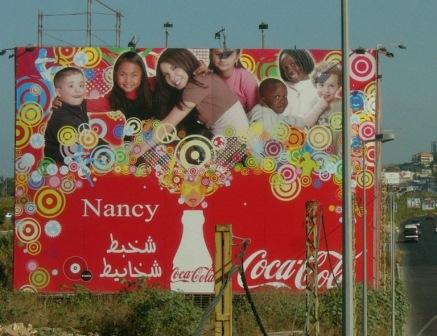
---Following reports that alcohol is among the ingredients of Coca-Cola, an Israeli Muslim from the Jezreel Valley decided to sue the company claiming it has caused grievous injury to his religious sentiments. “If it is true, then it’s a scandal. They fooled me all these years, causing me to transgress and sin.” Muhammad Mifra, age 67 from the village of Sulam near Afula, drank Coke for decades. Yesterday (Tuesday) after exposure to the popular drink’s secret recipe, he grew angry. He discovered that he may have transgressed one of the most severe sins of the Muslim religion – drinking alcohol – and now he intends to sue the company. The revelation of Coca Cola’s 125 year old secret recipe angered Mifra, a devout Muslim, and his family. If it is true that the recipe contains alcohol, then many Muslims around the world have for years been drinking alcohol against the laws of Islam.--- Read More:http://www.israelnewsguide.com/deeply-offended-muslim-to-sue-coca-cola
…An early example of this global marketing tactic was found in a Coca Cola commercial from 1971 featuring children from many different countries innocently singing, “I’d like to teach the world to sing in perfect harmony/I’d like to buy the world a Coke to keep it company.” This commercial illustrates an attempt to portray a U.S. goods as a product capable of transcending political, ethnic, religious, social, and economic differences to unite the world (according to the Coca-Cola Company, we can achieve world peace through consumerism)- Julia Galeota.Read More:http://www.thehumanist.org/humanist/articles/essay3mayjune04.pdf
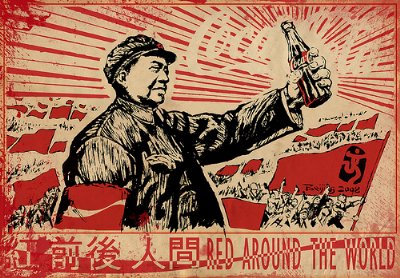
---The slogan, “Red Around the World,” clearly references the color of Coca Cola marketing, but it is also the color China uses to represent itself, as well as the color associated with communism. Meanwhile, the visual of the ad invokes communist propaganda. Coca Cola appears to be solidly on China’s side in this ad, even leading the charge towards a Chinese communist take-over of the world (if I may be a bit dramatic).--- Read More:http://thesocietypages.org/socimages/2010/12/02/coca-cola-an-american-icon-goes-to-china/
ADDENDUM:
Daniel Rathwell:Its television adverts, broadcast in the Middle East, juxtapose the infamous images of US troops torturing Iraqis in Abu Ghraib with film of young Arab children, smiling, holding cans of Mecca Cola in one hand and Palestinian flags in the other. The message is that you should buy Mecca Cola to support Palestinians and Iraqis in their struggles against the oppressors
rther, to buy products like Mecca and Qibla is to participate in their struggles….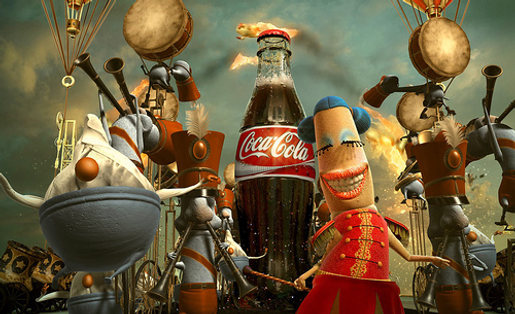
---It may indeed be true that the US practices imperialism, but it is a different kind of empire, on a Foucaultian basis. It does not reply on gunboat diplomacy, but on power spread through commerce and culture, by individual players in commerce and culture, who may not even realize their role in spreading and perpetuating power structures. "Spreading US hegemony" does not factor in the corporate vision of McDonalds, Nike, or Coca-Cola. If you asked their boards of directors about the support of hegemony, I think they would be genuinely confused. Their goal is to make profits. Nevertheless, they are spreading US cultural and economic hegemony without even realizing it. This means that airstrikes and military action are now a much lesser part of spreading imperialism. They are 19th-century methods. The state is as much a victim of Foucaultian imperialism as it is a perpetuator of it. If, as Canadian Dimension alleges, the Libyan intervention is due to Qaddafi's ejection of Western oil firms, can we really say that the response of Western states is "their" imperialism?--- Read More:http://hugochesshire.com/index.php/2011/03/23/can-we-declare-a-no-fly-zone-over-garbage image:http://blog.media-freaks.com/machine-dispenses-happiness-unsuspecting-college-students-viral-video-hit/
…But is refusing Coke and drinking Qibla supporting the cause? If so, the cause has become very easy to support. As well as buying Youth from Coca-Cola and Victory from Nike, we can now buy Protest and Conscience from Qibla Cola.
Qibla Cola describes its fizzy lemon-lime drink Qibla as representing ‘the choice of people who wish to rebuild their taste upon the correct foundation instead of the pillars of greed, selfishness, utilitarianism, justice and exploitation’ . And ‘shattering the myth that belief is blind’ comes Qibla Fantasy, its fizzy orange drink. ‘Despite an environment in which we have an opportunity to choose’, it says, ‘that choice is guided, directed and cajoled into accepting blind values, with unobtainable images. These restrictions must be replaced with conviction in your ideas, certainty in faith, and an assurance of decision’ .
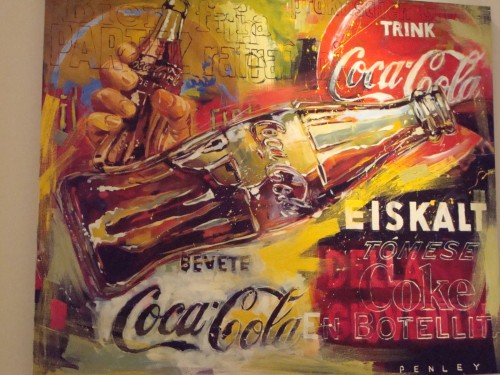
---Coca Cola is one of the most recognized brands in the world, and is one of the long-surviving brands that is still recognizable from its original incarnation. The logo is a classic, widely recognized and unique artwork by itself. ...Read More:http://www.presidiacreative.com/75-inspiring-coca-cola-advertisements-and-posters/
Do these barely decipherable slogans represent a revolutionary new anti-capitalism? Or are they proof of the inevitable banality in product marketing, regardless of political and spiritual will, clumsy jingles scratched out to appeal to a target market? Read More:http://www.thinking-east.net/indexa2ec.html?option=com_content&task=view&id=143
Read More:http://www.killercoke.org/nl070123.php
Read More:http://washnames.wordpress.com/2010/04/14/indian-director-of-anti-coca-cola-documentaries-dies-in-rail-accident/
—————————————–

Zizek:and the paradox of the superego, long ago perceived by Freud. The more profit you have, the more you want, the more you drink Coke, the more you are thirsty, the more you obey the superego command, the more you are guilty. In all three cases, the logic of balanced exchange is disturbed in favor of an excessive logic of "the more you give the more you owe", or the "more you possess what you are longing for, the more you are missing and thus the greater your craving", or the consumerist version, "the more you buy the more you must spend". This paradox is the very opposite of the paradox of love where, as Juliet put it to Romeo, "the more I give, the more I have." This superego–paradox also allows us to throw new light onto the functioning of today’s art scene. Its basic feature is not only the much deplored commodification of the culture, but also the less noted, perhaps even more crucial opposite movement: the growing culturalization of the market economy itself....Read More:http://www.egs.edu/faculty/slavoj-zizek/articles/the-superego-and-the-act/ image:http://www.geekologie.com/mt/mt-search.cgi?blog_id=1&tag=OMG
Marine Voskanyan:The efficiency of this strategy may be illustrated with examples from advertising policy of major corporations. Not long ago, someone produced a video clip featuring a bottle of Coke that ejects a fountain when a Mentos chewing candy is dropped into it. Instead of suing the sarcastic author, Coca-Cola and Mentos, realizing that the clip was very popular, launched a joint promotion campaign. The competition, run under the title “Poetry in Motion”, urged the visitors of the website to create video clips, associated with the theme of challenge….

--The book quotes Henry Miller, too. In The Air-Conditioned Nightmare, Miller wrote that “without a Coca-Cola life is unbearable.” Yet that’s part of a longer passage, a list that indicts the nightmarish America Miller found when he returned after years abroad. Here are a few other things he lists with Coca-Cola: “internal douche treatments, lousy photography, institutes of religion, faces lifted, warts removed, flatulence dissipated, business improved, limousines rented.” You should know better than to use something from a book called The Air-Conditioned Nightmare to bolster your brand. Clearly, Assouline and Coke don’t expect anybody to read that book.---Read More:http://www.theparisreview.org/blog/2011/06/02/the-coke-side-of-life/
…The authors were supposed to demonstrate the way usual objects could be used for extraordinary purposes, the photo of the “experiment” with the candy becoming the official emblem of the competition. Pete Blackshaw, marketing director of Nielsen/BuzzMetrics, the company that monitored virus technologies on a contract with Coca Cola, argued that viruses could be used as a good means for advertising. MarketingVox quotes Blackshaw’s remark: “Instead of addressing an advertising agency for elaboration of a promo campaign, we could just borrow it from a virus clip”. Thus, the attempt of Internet users to mock the tycoons of food production was used against them by the corporate logic of marketologists.Read More:http://www.globoscope.ru/eng/content/articles/297/
—————————————————-
A.S. Hamrah:Coke represents the eternally unsatisfied emptiness we seek to fill with something ungraspable, something Coke made eminently graspable in the form of its perfectly curved bottle, which was designed so you could recognize it in the dark by touch. The “contour bottle” debuted in 1916, the same year Einstein proved via the general theory of relativity that space was curved. A significant coincidence, I think. Other famous commenters on Coke who are MIA include Billy Wilder, who made a whole Mad Men–era movie about selling Coke behind the Iron Curtain, and Jean-Luc Godard, who mentioned or showed Coke in almost every movie he made in the 1960s. If Coke can claim Warhol and Miller for their own, surely they will absorb others. Read More:http://www.theparisreview.org/blog/2011/06/02/the-coke-side-of-life/





 COMMENTS
COMMENTS